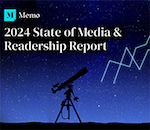Despite historic newsroom layoffs, shrinking advertising budgets, declining public trust in the media and ongoing concerns regarding the effect that new technology has on how information is created and consumed, the next generation of journalists remains optimistic about the future of their profession, according to a new study released by Chicago-based B2B communications agency Greentarget.
However, the journalists of tomorrow also highlighted several professional challenges facing them as they enter the workforce. Chief among them: artificial intelligence and misinformation.
Greentarget’s report, which surveyed young journalists—including current journalism students as well as reporters just entering the workforce—to gauge their perspectives on where they think the profession is heading, found that half (50 percent) believe that the introduction of AI poses a threat to journalists as well as those in related careers. Nearly three-quarters (74 percent) also think AI or automated journalism will have a significant impact on their industry.
That said, the next generation of journalists also generally view AI as a useful tool, and the majority admitted they’ve already used AI technology in their reporting in some form or another. More than half (52 percent) said they’ve used AI translation tools, 43 percent have used AI writing tools, 39 percent have used AI research tools, 21 percent have used AI copy-editing tools and nine percent have used AI organizational tools.
 |
| Young journalists who believe that the introduction of AI is a threat to journalists as well as those in related careers. |
Additionally, 57 percent reported that AI—or at least its potential impact—has been or was a component of their education.
A bigger perceived threat seems to be the ongoing spread of fake or inaccurate news. An overwhelming number of beginner journalists (91 percent) believe that misinformation and disinformation have negatively impacted journalism. And many expect the problem to get worse: nearly half (47 percent) said they believe the prevalence of fake news will only grow in the next year.
That said, only 25 percent said the prevalence of misinformation and/or disinformation has diminished their interest in journalism, while a majority (55 percent) said it has actually reinforced their devotion to the profession.
Most journalists believe that the factor most responsible for worsening the future spread of misinformation will be social media platforms (76 percent), followed by election campaigns (61 percent), geopolitical tensions (56 percent) and presidential administrations (45 percent).
A majority of respondents (67 percent) said they believe it will fall mainly on the shoulders of journalists to identify and combat inaccurate information circulated by both news outlets and social media. This was followed by fact-checking websites (65 percent), editors (63 percent), social media companies (55 percent), the government (48 percent) and cybersecurity companies (42 percent).
Nine out of 10 journalists surveyed (91 percent) said they plan to do what they can to combat the spread of misinformation or disinformation in their profession.
Despite the ubiquity of social media platforms and the myriad technological advancements that have disrupted how journalists get story ideas and vet information, traditional journalistic methods still reign supreme for young reporters. Reporting in the field (94 percent), drawing from primary-source networks (92 percent) and looking to experts and think tanks (92 percent) remain the most widely-cited resources for new journalists.
It also appears that most journalists entering the field are also purpose-driven. According to the survey, nearly two-thirds (62 percent) said their top motivation for becoming a journalist was to help the public make informed decisions by providing information, followed by exposing injustice (58 percent) and fighting misinformation and disinformation (45 percent).
More than half (59 percent) also said they’re concerned about a current lack of diversity in journalism.
Despite the aforementioned challenges, the next generation of reporters appear positive about where journalism is heading, with 72 percent saying they have an optimistic outlook regarding the future of their profession.
Greentarget’s “Next-Gen Journalists: Navigating Misinformation, AI & The Future of Journalism” report surveyed 100 journalism students and new professionals via an online survey.
Most respondents (57 percent) were students currently enrolled wither at an undergraduate or graduate journalism program. Only 21 percent were currently working journalists.


 Trump Media & Technology Group today reported a $58.2M net loss on $4.1M in 2023 revenues, a disclosure that drove its stock price down 22.6 percent to $47.96.
Trump Media & Technology Group today reported a $58.2M net loss on $4.1M in 2023 revenues, a disclosure that drove its stock price down 22.6 percent to $47.96. Barry Pollack, an attorney at Wall Street’s Harris St. Laurent & Wechsler, has registered Julian Assange as a client with the Justice Dept. “out of an abundance of caution.”
Barry Pollack, an attorney at Wall Street’s Harris St. Laurent & Wechsler, has registered Julian Assange as a client with the Justice Dept. “out of an abundance of caution.” Paramount Global to slash 800 jobs in what chief executive Bob Bakish calls part of an effort to “return the company to earnings growth"... Rolling Stone editor-in-chief Noah Shachtman is exiting at the end of the month due to disagreements with chief executive Gus Wenner over the direction the magazine is taking... The New York Times broke the $1 billion barrier in annual revenue from digital subscriptions in 2023... Press Forward is investing more than $500 million to strengthen local newsrooms.
Paramount Global to slash 800 jobs in what chief executive Bob Bakish calls part of an effort to “return the company to earnings growth"... Rolling Stone editor-in-chief Noah Shachtman is exiting at the end of the month due to disagreements with chief executive Gus Wenner over the direction the magazine is taking... The New York Times broke the $1 billion barrier in annual revenue from digital subscriptions in 2023... Press Forward is investing more than $500 million to strengthen local newsrooms. The majority of news articles are read within the first three days of publication, according to a recent report.
The majority of news articles are read within the first three days of publication, according to a recent report. The Los Angeles Times gives pink slips to 115 people or 20 percent of its newsroom staff... TIME is also laying off about 30 employees, which is approximately 15 percent of its editorial staff... The Baltimore Banner, which was launched by Stewart Bainum in 2022 after he failed to buy the Baltimore Sun, added 500 subscribers per day in the three days following Sinclair Broadcast Group's deal to purchase the Sun.
The Los Angeles Times gives pink slips to 115 people or 20 percent of its newsroom staff... TIME is also laying off about 30 employees, which is approximately 15 percent of its editorial staff... The Baltimore Banner, which was launched by Stewart Bainum in 2022 after he failed to buy the Baltimore Sun, added 500 subscribers per day in the three days following Sinclair Broadcast Group's deal to purchase the Sun.


 Have a comment? Send it to
Have a comment? Send it to 
No comments have been submitted for this story yet.